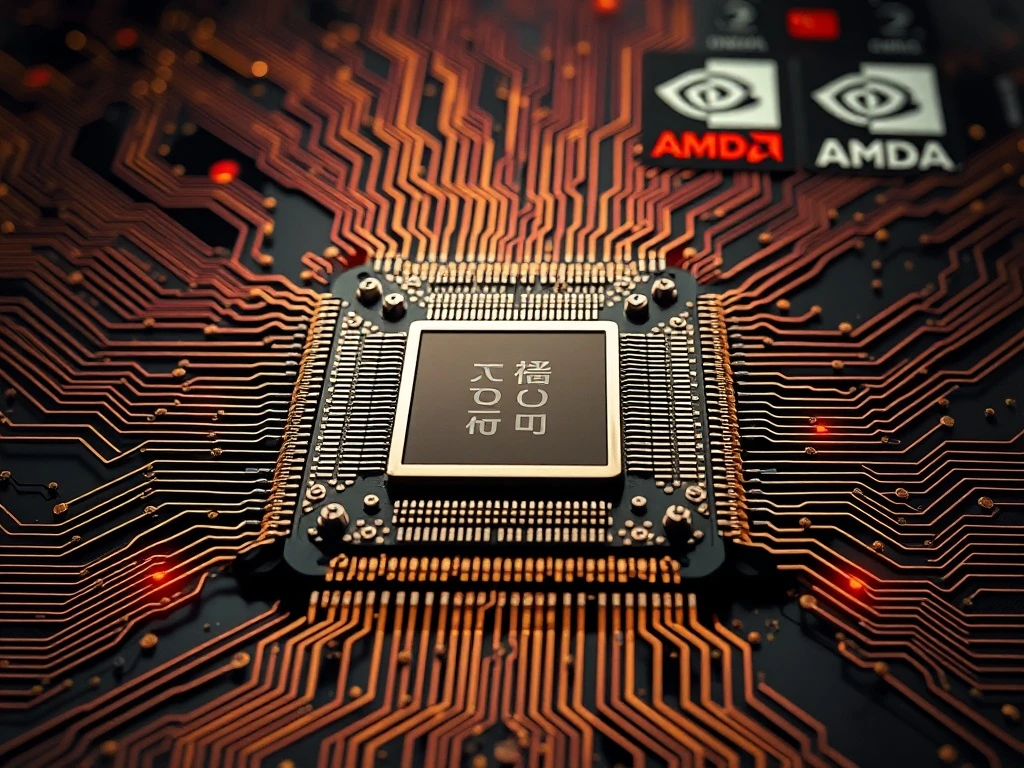Global technology landscapes are undergoing a profound transformation. Major shifts in supply chains are reshaping international trade. Specifically, China is signaling a significant pivot away from reliance on foreign technology. This strategic move impacts global tech giants. It creates new challenges and opportunities within the semiconductor industry. Beijing’s assertive stance prioritizes domestic innovation. It aims for self-sufficiency in critical technological sectors. This includes the crucial area of advanced semiconductors. Consequently, companies like Nvidia and AMD are finding their traditional market access in China challenged. This marks a pivotal moment in the pursuit of **China chip independence**.
The Genesis of China Chip Independence
China’s quest for **China chip independence** did not emerge overnight. It is a direct response to escalating geopolitical tensions. Furthermore, it reflects a long-term national strategy. Historically, China heavily relied on foreign semiconductor technology. This dependence became a vulnerability. Particularly, US export controls tightened significantly. These restrictions aimed to limit China’s access to advanced chips. They targeted specific technologies and equipment. The US government cited national security concerns. These actions served as a powerful catalyst for Beijing. They underscored the urgent need for domestic capabilities. China’s leadership recognized this strategic imperative. They initiated a massive push for self-reliance. This effort spans research, development, and manufacturing. Ultimately, the goal is to build a robust domestic semiconductor ecosystem. This ensures uninterrupted access to essential components. It also reduces reliance on external suppliers.
For many years, China’s tech companies thrived using foreign chips. They integrated advanced processors from firms like Nvidia and AMD. These components powered everything. They supported consumer electronics to data centers. However, the landscape shifted dramatically. New regulations restricted high-performance chips. These restrictions specifically targeted China. As a result, Beijing accelerated its domestic agenda. It views chip self-sufficiency as a matter of national security. It is also an economic imperative. This strategic pivot signals a new era. It means global technology supply chains are decoupling. Therefore, the drive for **China chip independence** gained immense momentum.
Beijing’s Multi-Pronged Approach to Self-Sufficiency
Beijing employs a comprehensive strategy to achieve **China chip independence**. This approach involves substantial financial investment. It also includes policy support and talent cultivation. Firstly, the government has poured billions into the semiconductor sector. This funding comes from various state-backed initiatives. For example, the National Integrated Circuit Industry Investment Fund, or the ‘Big Fund,’ plays a key role. It supports domestic chip companies. It invests in manufacturing, design, and equipment firms. Secondly, China emphasizes research and development (R&D). National laboratories and universities receive significant grants. They focus on breakthroughs in chip design and fabrication. This includes areas like advanced packaging and materials science. Furthermore, Beijing encourages collaboration among domestic firms. This fosters a more integrated supply chain within China.
Moreover, talent development is a critical component. China is investing heavily in semiconductor education. It establishes new engineering programs. It also attracts top talent. Both domestic and international experts are targeted. Policies offer incentives for skilled professionals. They encourage them to join Chinese chip companies. Furthermore, the government implements preferential tax policies. These policies support local semiconductor businesses. They also provide subsidies for production. Such measures aim to reduce costs. They also enhance the competitiveness of Chinese chips. This holistic approach strengthens the entire industry. It covers everything from basic research to mass production. Ultimately, these efforts are designed to ensure long-term **China chip independence**.
Impact on Global Chip Giants: Nvidia and AMD’s Shifting Landscape
The intensifying drive for **China chip independence** directly impacts global semiconductor leaders. Nvidia and AMD are prominent examples. Both companies traditionally held significant market share in China. They supplied high-performance GPUs and CPUs. These components were essential for various applications. They powered gaming, data centers, and artificial intelligence. However, US export controls have altered this dynamic. These regulations restrict the sale of advanced chips to China. This forces Nvidia and AMD to develop downgraded versions of their products. These versions comply with the export rules. Consequently, their revenue streams from China face pressure. This situation encourages Chinese customers to seek domestic alternatives. They prioritize suppliers not subject to US restrictions.
Nvidia, for instance, introduced specific chips for the Chinese market. These chips feature reduced performance. They comply with export regulations. Similarly, AMD navigates these complex trade rules. Both companies must balance compliance with market access. This challenge is substantial. They risk losing market share if their offerings are uncompetitive. Alternatively, they risk penalties if they violate regulations. This complex environment forces strategic adjustments. It prompts a re-evaluation of their China strategies. The long-term outlook for their business in China remains uncertain. The push for **China chip independence** continues to accelerate. This will likely lead to further shifts in market dynamics. Thus, Nvidia and AMD must adapt quickly.
Emergence of Domestic Champions in China Chip Independence
China’s strategic push has fostered the rapid growth of domestic chip companies. These firms are now emerging as significant players. They aim to fill the void left by restricted foreign technology. Semiconductor Manufacturing International Corporation (SMIC) is a prime example. It is China’s largest contract chipmaker. SMIC has made strides in production capabilities. While still behind global leaders like TSMC, it continues to advance. Huawei’s HiSilicon also represents a key domestic champion. Despite US sanctions, HiSilicon continues its chip design efforts. It leverages its extensive R&D capabilities. Furthermore, numerous smaller, specialized firms are gaining traction. These companies focus on specific niches. They develop chips for AI, automotive, and consumer electronics. This diversified approach strengthens the overall domestic ecosystem.
These Chinese companies benefit from massive state support. They receive financial aid and preferential policies. They also gain access to a vast domestic market. This allows them to scale production rapidly. Their focus is on building a complete domestic supply chain. This includes materials, equipment, and intellectual property. The progress of these champions is crucial for **China chip independence**. While challenges remain, their advancements are undeniable. They are increasingly capable of meeting domestic demand. This reduces China’s reliance on foreign suppliers. Their rise signifies a fundamental shift. It marks a new competitive landscape in the global semiconductor industry. This trend will likely continue shaping the market.
Navigating the Hurdles: The Path Ahead for China Chip Independence
Achieving complete **China chip independence** presents significant hurdles. The most formidable challenge lies in advanced lithography. This technology is essential for producing cutting-edge chips. Dutch firm ASML dominates this field. Its extreme ultraviolet (EUV) lithography machines are unparalleled. China lacks access to these advanced tools. Export controls prevent their sale to Chinese companies. This limitation affects China’s ability to produce chips at the most advanced nodes. Without EUV technology, Chinese foundries struggle to compete. They cannot produce the smallest, most powerful chips. Therefore, this technological gap remains a critical barrier. It requires substantial innovation and investment to overcome.
Furthermore, intellectual property (IP) acquisition is another challenge. Many foundational semiconductor IPs are held by Western companies. China needs to develop its own robust IP portfolio. This ensures long-term self-sufficiency. It also reduces reliance on licensed technologies. Talent retention is also crucial. Attracting and keeping top engineers is competitive. Global demand for chip experts is high. Despite significant investment, China must continuously foster a strong talent pipeline. Overcoming these obstacles will require sustained effort. It demands massive investment in R&D. It also necessitates strategic international partnerships where possible. The path to full **China chip independence** is long and complex. It requires continuous innovation and resilience.
Broader Implications for the Semiconductor Ecosystem
The pursuit of **China chip independence** carries profound implications. It affects the entire global semiconductor ecosystem. Firstly, it accelerates the decoupling of tech supply chains. Countries are increasingly prioritizing national security. They aim to reduce dependencies on potential adversaries. This trend could lead to fragmented markets. It may also result in redundant manufacturing capacities worldwide. Secondly, it could spur innovation in new regions. As China invests heavily, other nations may follow suit. They will bolster their own domestic capabilities. This competition could drive technological advancements. It might also lead to more diversified supply chains. However, it could also increase overall costs.
Moreover, the geopolitical landscape will likely intensify. Technology is now a central battleground. Nations are competing for technological supremacy. This rivalry impacts trade relations and diplomatic ties. Furthermore, companies like Nvidia and AMD face strategic dilemmas. They must adapt to a world with less access to the Chinese market. This might force them to diversify their customer base. They may also need to explore new product lines. Ultimately, the shift towards **China chip independence** reshapes global commerce. It transforms technological collaboration. It will define the future of the semiconductor industry for decades to come.
In conclusion, China’s determined push for **China chip independence** marks a watershed moment. It signals a fundamental restructuring of the global tech industry. This strategic pivot, driven by national security and economic imperatives, directly impacts leading foreign chipmakers like Nvidia and AMD. While significant hurdles remain, particularly in advanced manufacturing, China’s sustained investment and policy support are fostering a robust domestic semiconductor ecosystem. The long-term consequences will likely include fragmented supply chains, intensified geopolitical competition, and a redefinition of technological leadership worldwide. This ongoing transformation will continue to shape the future of innovation and global trade.
Frequently Asked Questions (FAQs)
What is China chip independence?
China chip independence refers to Beijing’s strategic goal of achieving self-sufficiency in semiconductor technology. This means China aims to design, manufacture, and supply its own chips without relying on foreign companies or technologies, particularly from the United States.
Why is China pursuing semiconductor self-sufficiency?
China is pursuing semiconductor self-sufficiency primarily due to national security concerns and economic stability. US export controls have restricted China’s access to advanced chips, highlighting its vulnerability. This push ensures a stable supply of critical components and fosters domestic technological advancement.
How do US export controls impact companies like Nvidia and AMD in China?
US export controls limit the types of advanced chips Nvidia and AMD can sell to China. This forces them to offer downgraded versions of their products, potentially reducing their revenue and market share. It also encourages Chinese customers to seek out domestic alternatives.
What are the biggest challenges for China in achieving chip independence?
The biggest challenges for China include gaining access to advanced lithography equipment, particularly EUV machines from ASML, which are crucial for producing cutting-edge chips. Developing its own intellectual property and retaining top talent in the semiconductor field are also significant hurdles.
Which Chinese companies are leading the push for domestic chip production?
Key Chinese companies leading the push for domestic chip production include Semiconductor Manufacturing International Corporation (SMIC), China’s largest contract chipmaker, and Huawei’s HiSilicon, which focuses on chip design. Many smaller, specialized firms are also contributing to this effort across various segments of the industry.
What are the global implications of China’s drive for chip independence?
The global implications include accelerated decoupling of tech supply chains, increased geopolitical tensions over technology, and potential fragmentation of global markets. It could also spur innovation in new regions and force international companies to diversify their strategies and customer bases.






